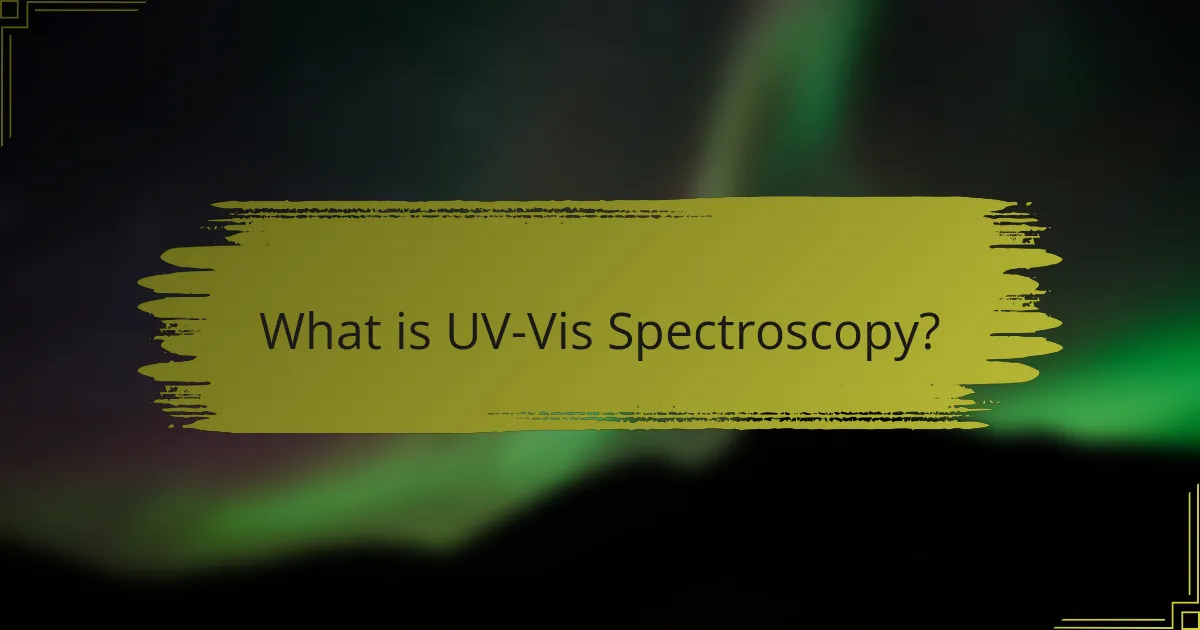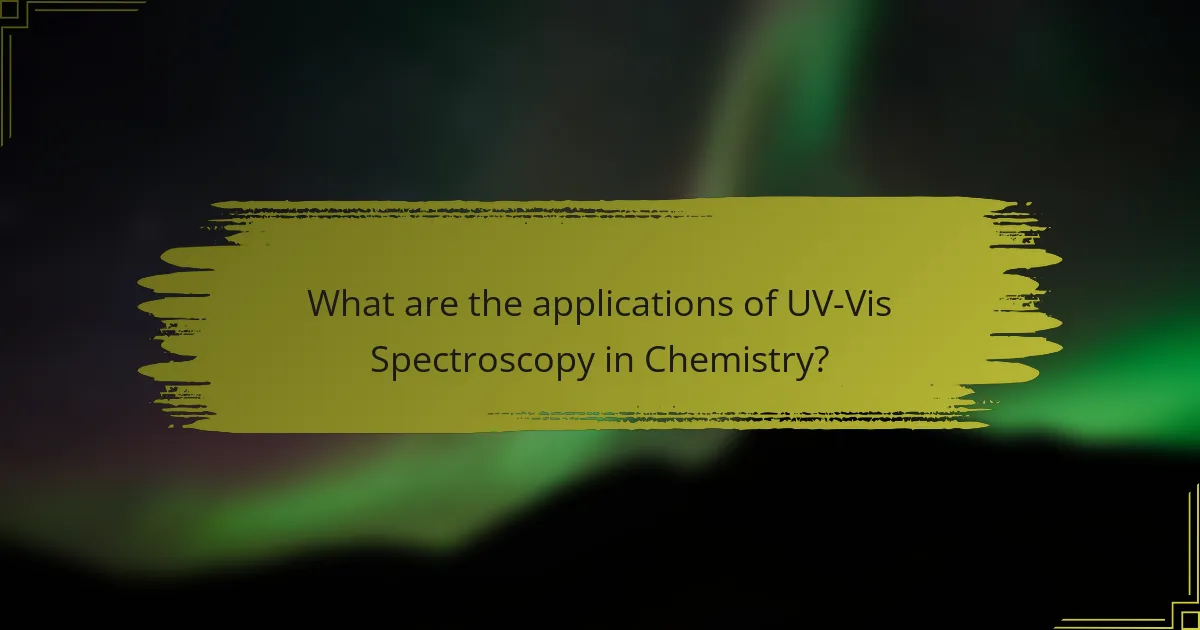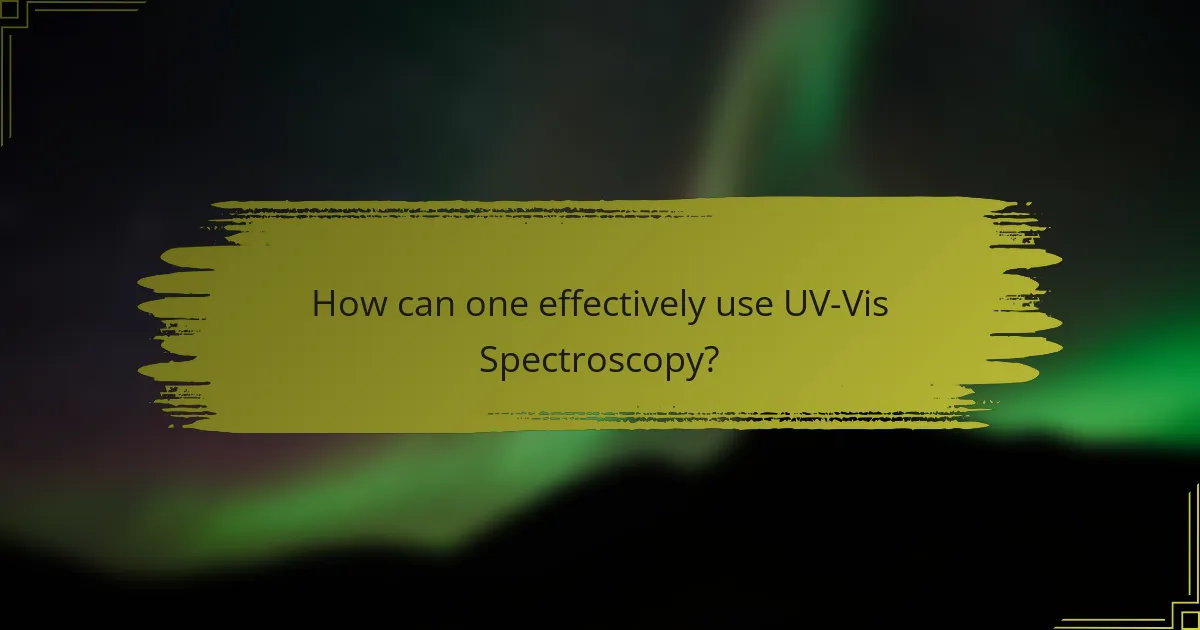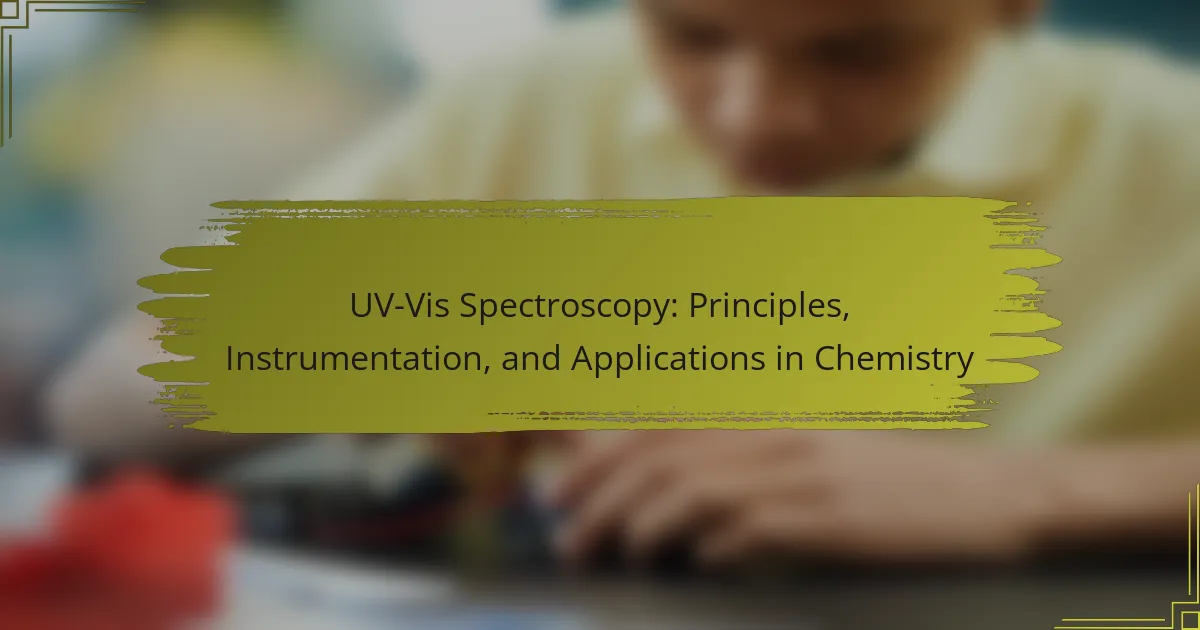
What is UV-Vis Spectroscopy?
UV-Vis Spectroscopy is an analytical technique used to measure the absorption of ultraviolet and visible light by a substance. This method helps in determining the concentration of solutes in a solution. UV-Vis Spectroscopy operates on the principle that molecules absorb light at specific wavelengths. The amount of light absorbed correlates with the concentration of the absorbing species. This relationship is described by Beer-Lambert Law. The technique is widely used in chemistry for qualitative and quantitative analysis. It is applicable in various fields, including biochemistry and environmental science.
How does UV-Vis Spectroscopy work?
UV-Vis spectroscopy works by measuring the absorbance of ultraviolet and visible light by a sample. Light from a UV-Vis light source passes through a monochromator, which separates the light into specific wavelengths. The selected wavelength then travels through the sample, where some light is absorbed by the molecules present. The remaining light is detected by a photodetector, which converts the light intensity into an electrical signal. This signal is then analyzed to determine the absorbance at each wavelength. The absorbance data can be plotted to create a spectrum, which provides information about the sample’s molecular structure and concentration. UV-Vis spectroscopy is widely used in chemistry for quantitative analysis and identifying substances based on their unique absorption characteristics.
What are the fundamental principles underlying UV-Vis Spectroscopy?
UV-Vis Spectroscopy is based on the absorption of ultraviolet or visible light by molecules. When light passes through a sample, certain wavelengths are absorbed, causing electronic transitions in the molecules. This absorption occurs when electrons move from a ground state to an excited state. The amount of light absorbed at each wavelength is measured to generate a spectrum. The resulting spectrum provides information about the molecular structure and concentration of the sample. Beer-Lambert Law relates absorbance to concentration and path length, demonstrating a linear relationship. This principle allows for quantitative analysis of substances in solution.
How is light absorption measured in UV-Vis Spectroscopy?
Light absorption in UV-Vis Spectroscopy is measured using a spectrophotometer. The spectrophotometer directs ultraviolet or visible light through a sample. As the light passes through, some wavelengths are absorbed by the sample, while others are transmitted. The instrument measures the intensity of transmitted light compared to the intensity of the incident light. This comparison yields absorbance values. Absorbance is calculated using Beer-Lambert Law, which states that absorbance is directly proportional to the concentration of the absorbing species and the path length of the light. The formula is A = εcl, where A is absorbance, ε is the molar absorptivity, c is the concentration, and l is the path length. This method provides quantitative data on the sample’s light absorption characteristics.
What are the key components of a UV-Vis Spectroscopy instrument?
The key components of a UV-Vis Spectroscopy instrument include a light source, monochromator, sample holder, detector, and data processing system. The light source typically emits ultraviolet and visible light, often using a deuterium lamp or tungsten lamp. The monochromator isolates specific wavelengths of light to direct towards the sample. The sample holder contains the cuvette, which holds the sample for analysis. The detector measures the intensity of transmitted light, converting it into an electrical signal. The data processing system analyzes the signal and generates a spectrum. These components work together to enable the measurement of absorbance or transmittance of light by a sample.
What types of light sources are used in UV-Vis Spectroscopy?
UV-Vis Spectroscopy primarily uses three types of light sources: tungsten lamps, deuterium lamps, and xenon lamps. Tungsten lamps emit visible light and near-infrared radiation, making them suitable for the visible range. Deuterium lamps provide a continuous spectrum in the ultraviolet region, typically from 160 to 400 nm. Xenon lamps generate a broad spectrum of light that covers both UV and visible ranges, ideal for various applications. Each light source is selected based on the specific wavelength range needed for analysis.
How do detectors function in UV-Vis Spectroscopy?
Detectors in UV-Vis spectroscopy function by converting light into an electrical signal. They measure the intensity of light transmitted through a sample. Photomultiplier tubes (PMTs) and photodiodes are common types of detectors used. These detectors respond to specific wavelengths of light. When light hits the detector, it generates a current proportional to the light intensity. This current is then amplified and converted into a readable signal. The signal is processed to provide absorbance or transmittance data. Accurate measurements depend on the detector’s sensitivity and response time. High-quality detectors enhance the overall performance of UV-Vis spectrometers.

What are the applications of UV-Vis Spectroscopy in Chemistry?
UV-Vis spectroscopy is widely used in chemistry for various applications. One primary application is quantitative analysis of substances. This technique measures absorbance, allowing for concentration determination using Beer-Lambert Law. Another application is in studying reaction kinetics. UV-Vis spectroscopy enables real-time monitoring of changes in absorbance during reactions.
Additionally, it is used for identifying and characterizing compounds. The absorption spectra provide fingerprints for different substances. UV-Vis spectroscopy is also employed in environmental chemistry. It helps analyze pollutants in water and air samples. In pharmaceutical chemistry, it is used for drug formulation and stability testing.
Moreover, UV-Vis spectroscopy plays a role in quality control. It ensures the consistency of products in various industries. Its versatility makes it an essential tool in both research and industrial applications.
How is UV-Vis Spectroscopy used in quantitative analysis?
UV-Vis spectroscopy is used in quantitative analysis to determine the concentration of a substance in a solution. This technique relies on the absorption of ultraviolet or visible light by the analyte. When light passes through a sample, specific wavelengths are absorbed based on the concentration of the substance. According to Beer-Lambert Law, absorbance is directly proportional to concentration. This relationship allows for the calculation of unknown concentrations by measuring absorbance at specific wavelengths. Calibration curves are often created using known standards to ensure accuracy. This method is widely applied in fields such as biochemistry, environmental analysis, and pharmaceuticals.
What is Beer’s Law and how does it apply to UV-Vis Spectroscopy?
Beer’s Law states that the absorbance of light by a solution is directly proportional to its concentration and the path length of the light. This relationship is expressed mathematically as A = εlc, where A is absorbance, ε is the molar absorptivity, l is the path length, and c is the concentration. In UV-Vis spectroscopy, Beer’s Law is fundamental for quantifying the concentration of analytes in solution. By measuring absorbance at specific wavelengths, chemists can determine the concentration of substances based on their unique absorption characteristics. This principle allows for precise analysis in various applications, including environmental monitoring and pharmaceutical testing. The validity of Beer’s Law in UV-Vis spectroscopy is supported by extensive empirical data demonstrating its applicability across a wide range of concentrations and solutions.
What are the limitations of using UV-Vis Spectroscopy for quantitative analysis?
UV-Vis Spectroscopy has several limitations for quantitative analysis. One major limitation is its sensitivity to sample concentration. High concentrations can lead to deviations from Beer-Lambert Law. This law assumes a linear relationship between absorbance and concentration, which may not hold true at elevated concentrations. Another limitation is interference from other substances. Competing chromophores can absorb at similar wavelengths, affecting accuracy. Additionally, UV-Vis Spectroscopy is limited to analyzing only colored or UV-absorbing samples. Non-absorbing samples cannot be quantified using this technique. Furthermore, the technique requires careful calibration. Inaccurate calibration can lead to significant errors in concentration determination. Lastly, temperature variations can affect absorbance readings. Accurate temperature control is essential for reliable results.
What role does UV-Vis Spectroscopy play in qualitative analysis?
UV-Vis Spectroscopy is essential in qualitative analysis for identifying chemical compounds. It detects absorbance of UV and visible light by substances. Each compound has a unique absorption spectrum. This spectrum acts like a fingerprint for identification. The technique allows for rapid analysis of samples. It can differentiate between similar compounds based on their spectral data. UV-Vis Spectroscopy is widely used in pharmaceuticals and environmental testing. Its ability to provide specific information about molecular structure enhances qualitative analysis accuracy.
How can UV-Vis Spectroscopy help identify unknown substances?
UV-Vis Spectroscopy helps identify unknown substances by analyzing their absorption spectra. Each substance has a unique absorption pattern in the ultraviolet and visible light range. When a sample is exposed to UV-Vis light, it absorbs specific wavelengths. The resulting spectrum displays peaks at these wavelengths. By comparing the spectrum of an unknown substance to reference spectra, identification becomes possible. This method is widely used in chemistry for qualitative analysis. It can detect concentrations as low as micromolar levels. Additionally, UV-Vis Spectroscopy is rapid and non-destructive, making it ideal for various applications.
What are common examples of qualitative analysis using UV-Vis Spectroscopy?
Common examples of qualitative analysis using UV-Vis Spectroscopy include the identification of pigments, determination of metal ions, and analysis of organic compounds. Pigments such as chlorophyll can be identified based on their characteristic absorption spectra. The presence of metal ions, like copper or iron, can be detected through specific absorbance peaks. Organic compounds often exhibit unique absorption patterns, allowing for their identification in mixtures. UV-Vis Spectroscopy is widely used in environmental testing, pharmaceuticals, and food quality control for these purposes.

How can one effectively use UV-Vis Spectroscopy?
To effectively use UV-Vis Spectroscopy, one should follow a structured approach. First, prepare the sample in a suitable solvent. The solvent must not absorb in the UV-Vis range. Next, calibrate the spectrophotometer using a blank sample. This ensures accurate baseline readings. Then, measure the absorbance of the sample at specific wavelengths. The wavelengths should correspond to the absorption peaks of the analyte. Record the data for analysis. Finally, analyze the absorbance values using Beer-Lambert law. This law relates absorbance to concentration, allowing for quantification. Proper sample handling and instrument calibration enhance measurement accuracy.
What best practices should be followed when conducting UV-Vis Spectroscopy?
Use clean cuvettes to avoid contamination and ensure accurate results. Calibrate the spectrophotometer before use to maintain precision. Select the appropriate wavelength for the analyte being measured. Ensure the sample is homogeneous to avoid inconsistent readings. Use a blank to zero the instrument and account for solvent effects. Measure absorbance within the linear range of the detector for reliable data. Record all parameters and conditions during the experiment for reproducibility. Properly store samples to prevent degradation before analysis.
How can sample preparation impact UV-Vis Spectroscopy results?
Sample preparation significantly impacts UV-Vis Spectroscopy results. Proper sample preparation ensures accurate absorbance measurements. Inadequate preparation can lead to sample degradation or contamination. Contaminants absorb light, skewing results and reducing sensitivity. The concentration of the sample must be appropriate for the instrument’s range. Dilution or concentration affects the path length and absorbance. Additionally, the choice of solvent influences the spectrum. Solvents can have their own absorbance characteristics, complicating interpretation. Overall, meticulous sample preparation is essential for reliable UV-Vis Spectroscopy outcomes.
What are common troubleshooting tips for UV-Vis Spectroscopy?
Check the baseline absorbance to ensure the instrument is calibrated properly. This can help identify issues with the light source or detector. Inspect the cuvettes for scratches or fingerprints, as these can affect readings. Ensure that the sample is properly prepared and free of bubbles. Validate the wavelength settings to confirm they match the desired analysis. Regularly clean the optical components to prevent interference from contaminants. Verify that the software settings are configured correctly for the specific analysis being performed. Finally, consult the manufacturer’s manual for specific troubleshooting steps related to the model in use.
How can UV-Vis Spectroscopy be integrated into research and development?
UV-Vis Spectroscopy can be integrated into research and development by providing quantitative analysis of substances. It allows researchers to determine the concentration of compounds in solutions. This technique is essential in various fields, including pharmaceuticals and environmental science. UV-Vis Spectroscopy helps in monitoring chemical reactions in real-time. It can also be used to assess the purity of samples. Furthermore, it facilitates the identification of unknown substances through absorbance spectra. The method is rapid and requires minimal sample preparation. These attributes make it a valuable tool in R&D settings.
What are the emerging trends in UV-Vis Spectroscopy applications?
Emerging trends in UV-Vis spectroscopy applications include advancements in miniaturization and portability. Compact devices are increasingly used for field analysis and on-site testing. Another trend is the integration of UV-Vis spectroscopy with other analytical techniques, enhancing data richness and accuracy. For example, combining UV-Vis with fluorescence spectroscopy improves detection limits for certain compounds. Additionally, machine learning algorithms are being applied to analyze spectroscopic data, enabling more efficient data interpretation. The use of UV-Vis spectroscopy in environmental monitoring is also growing, particularly for analyzing pollutants in water and air. These trends reflect the increasing demand for rapid and precise analytical methods in various fields.
How can UV-Vis Spectroscopy enhance analytical methods in chemistry?
UV-Vis Spectroscopy enhances analytical methods in chemistry by providing precise measurements of absorbance at specific wavelengths. This technique allows for the identification and quantification of chemical substances. It operates based on the principle that molecules absorb light in the ultraviolet and visible regions of the electromagnetic spectrum. The resulting absorbance data can indicate concentration levels according to Beer-Lambert Law.
Furthermore, UV-Vis Spectroscopy is rapid and non-destructive, making it suitable for various applications. It can analyze complex mixtures without extensive sample preparation. Studies have shown that this method can detect concentrations as low as micromolar levels. Its ability to monitor reaction kinetics in real-time further strengthens its utility in analytical chemistry.
UV-Vis Spectroscopy is an analytical technique used to measure the absorption of ultraviolet and visible light by substances, aiding in the determination of solute concentrations in solutions. The article covers the fundamental principles of UV-Vis Spectroscopy, including the Beer-Lambert Law, the components of a UV-Vis instrument, and the types of light sources and detectors used. It discusses various applications in chemistry, such as quantitative and qualitative analysis, and highlights best practices for effective use, sample preparation, and troubleshooting. Emerging trends and the integration of UV-Vis Spectroscopy into research and development are also explored, emphasizing its significance in various scientific fields.
